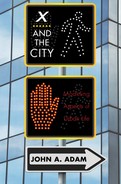Appendix 6
A SPIRAL BRAKING PATH
What is the path of a particle that is acted upon by a constant force? Since force is a vector quantity, this means that both the magnitude a and the direction of the force are constant. Suppose that the acceleration vector ā makes an angle γ with the trajectory, as indicated in Figure A6.1. Many calculus textbooks demonstrate that the components of acceleration (v being speed) along the tangent and normal to the path are, respectively,
![]()
where ρ is the (local) radius of curvature of the path. Resolving the acceleration in these directions yields the following equations:
![]()
In these expressions a = |ā|. Integrating the first equation, and noting that ρ = |ds/dψ|. gives the result
Figure A6.1. Path of the particle; ψ is the angle the tangent line makes with the polar axis, the arc length is s and the acceleration is a constant vector ā.
where B is a constant and we have assumed (without loss of generality) that ds/dψ>0. A further integration yields
![]()
D being another constant. Again, without loss of generality, assuming the argument of the logarithm is positive we find that the equation of the path is

Therefore the path is that of an equiangular spiral because (neglecting additive and multiplicative constants) it is of the form s = econstant xψ.

